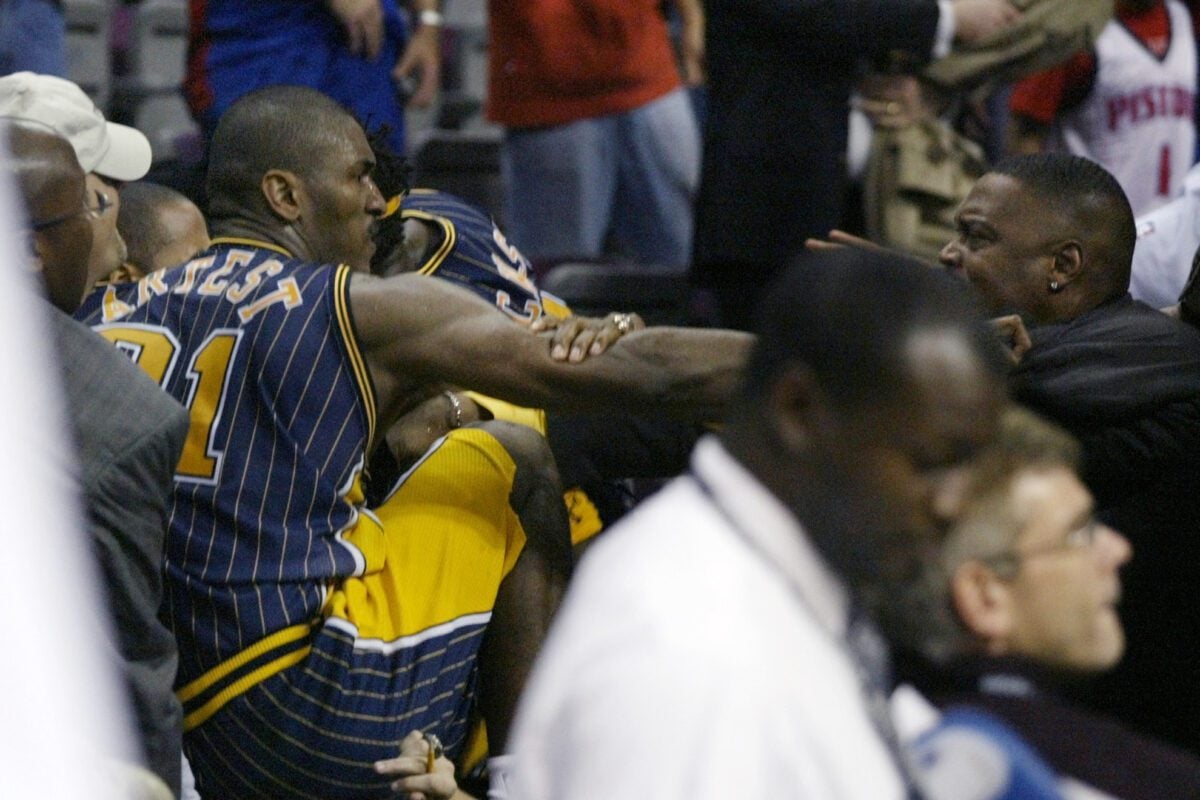The NBA witnessed one of its darkest chapters, a night of violence and chaos that forever etched itself into the league’s history, on Nov. 19, 2004. The infamous “Malice at the Palace” brawl, a melee involving players and fans that erupted during a game between the Indiana Pacers and the defending champion Detroit Pistons, stands as a stark reminder of the volatile nature of competitive sports and the potential consequences of unchecked emotions.
The events unfolded at The Palace of Auburn Hills in Auburn Hills, Michigan. With 46 seconds left in the game and the Pacers leading by a comfortable margin, Pistons center Ben Wallace committed a hard foul on Pacers forward Ron Artest (Metta World Peace.) Artest, known for his temperamental outbursts, reacted by charging into the stands, sparking a chain of events that would spiral into pandemonium.
The stands erupted as fans threw objects at Artest, who retaliated by throwing a cup back at them. Other Pacers players, including Stephen Jackson and Jermaine O’Neal, joined the altercation, and soon the court was engulfed in a chaotic brawl. Fans poured onto the court, throwing punches, drinks and exchanging blows with players. One fan threw a chair, which led to criminal charges. The scene was captured by television cameras, broadcasting the brutality to a horrified audience across the nation, becoming known as the ‘Malice at the Palace.’
Despite being an eighth grader then, I vividly remember the scuffle, from Artest laying down on the scorer’s table in an unorthodox fashion to the infamous sliding punch on a Pistons fan. I watched the final moments of a Friday night Pacers game with my grandmother, who grew instantly appalled at what was unfolding on the screen in our living room.

The brawl lasted for several minutes before security personnel intervened and restored order. Nine players were ejected from the game, and five fans were arrested. The NBA responded to the Malice at the Palace swiftly, issuing unprecedented suspensions to the players involved. Artest received an 86-game suspension, the longest in NBA history. In contrast, Jackson received a 30-game suspension while O’Neal was handed down a 25-game recess.
The ramifications of the Malice at the Palace extended far beyond the suspensions and fines. The Pacers, who many believe were in their championship window between 2001-2005, were left whirling from the incident. The team’s image was stained; the players’ morale severely affected. The Pacers’ performance declined significantly, and they failed to make the playoffs for the next two seasons.
Indianapolis also felt the impact of the brawl. The Pacers were a source of pride for the city, and the Malice at the Palace cast a shadow over their reputation on one of the world’s grandest stages. The incident also raised concerns about fan behavior and security measures at sporting events.
Then-NBA commissioner David Stern shared how the incidient changed the entire league nearly in a weekend.
“The brawl that happened between the Pistons and the Pacers provided much of the media in the course of that weekend to use the words ‘thugs’ and ‘punks,'” Stern said in an interview with CBS Sports Radio. “With respect to all of our players which to me is freighted with respect to what they’re really saying and brought up visions of the way the media treated us a decade or more earlier.”
As a league, the NBA faced a crisis of image and credibility following the Malice at the Palace. The brawl raised questions about the league’s culture and its ability to control the behavior of its players and fans. The NBA took a hard look at its policies and procedures to prevent similar incidents from happening in the future.
In the events following the Malice at the Palace, the NBA implemented many changes, including stricter penalties for on-court misconduct, increased security measures at arenas and programs to promote fan courtesy. The league also effortlessly improved its relationship with its players, fostering a more open and respectful dialogue.
In an interview following the incident, then-Indiana Pacers forward Stephen Jackson summed up the avenues that led to the Malice at the Palace:
“I think a lot of us made a lot of selfish decisions that day,” Jackson said. “I made a selfish decision to confront [the Detroit Pistons]. That was my selfish decision.” Jackson added, “Ron made a selfish decision by [entering] the stands. [Everyone] made selfish decisions.”
20 years later, Indianapolis will host the 2024 NBA All-Star Game.
Contact multimedia staff writer Noral Parham III at 317-762-7846 or via email at noralp@indyrecorder.com. Follow him on Twitter (‘X’) at @3Noral. For more news courtesy of the Indianapolis Recorder, click here. You can also visit the Indiana Minority Business Magazine by clicking here.
Noral Parham is the multi-media & senior sports reporter for the Indianapolis Recorder, one of the oldest Black publications in the country. Parham has worked with various leagues to provide a diverse perspective in sports, including the Big Ten, Big East, IHSAA, IndyCar, MLB, NHRA, NFL, NBA, WNBA, WWE and the Olympics. Prior to joining the Recorder, Parham served as the community advocate of the MLK Center in Indianapolis and senior copywriter for an e-commerce and marketing firm in Denver.










